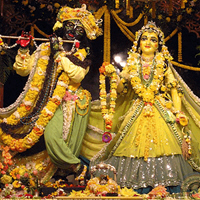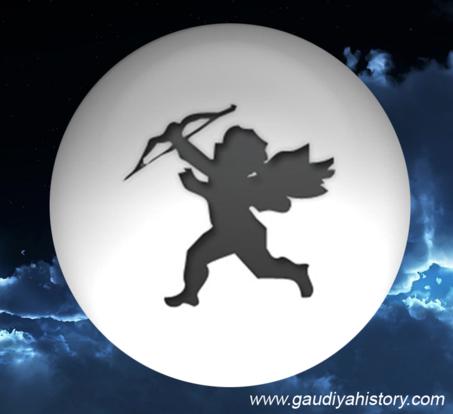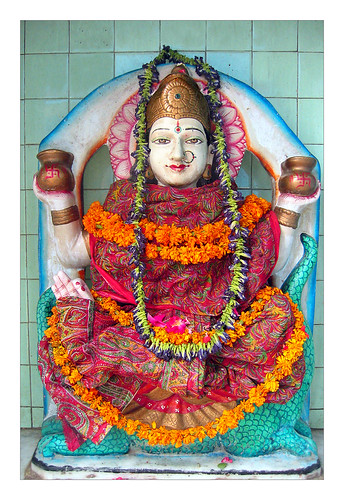All Posts (4030)
Appearing in 1638, Sri Visvanatha Cakravarti Thakura (Hari Vallabha Dasa) came in the disciplic succession from Sri Narottama Dasa Thakura. Visvanatha took diksa from Sri Radha Ramana Cakravarti. Although married, Visvanatha was indifferent and soon renounced family life. He came to Vrindavana dhama and did Krishna bhajana at Radha-kunda.
He was known as "the crest jewel of the Vaisnavas" because of his pure devotion, scholarship, and realized perception of Radha Gokulananda's intimate conjugal pastimes. Gaudiya authorities say that Sri Rupa Goswami is vag-devavatara (an incarnation of the god of speech). And Gaudiya acaryas, especially among his direct disciples, believe that Visvanatha Cakravarti Thakura is an incarnation of Sri Rupa Goswami.
Among all Gaudiya Vaisnava acaryas only Visvanatha Cakravarti comes close to matching Srila Rupa Goswami's profound realizations on the Absolute Truth. Visvanatha Cakravarti's name itself implies his position. Visvanatha means "He who reveals the
vrishabhanutaya khyatah pura yo vraja-mandale
Shri Uddhav das sings the glories of Raghunandan, who is non different from Madan (Cupid).
Shri Mukunda Das, Madhava Das and Shri Narahari Sarakar Thakur were three brothers who lived in the village of Shri Khanda. Raghunandan was the son of Shri Mukunda Das. [C. C. Mad 15]
In the house of Shri Mukunda Das, who lives at Shri Khanda, Lord Shri Gopinath is served with great devotion. One day Mukunda was called out to do some work, and then he instructed his son Raghunandan to worship the Deity and asked him to serve the Lord Gopinath that day. He explained to him that this Deity is in our family for many generations and thus He has been worshipped by my father and his father and his father on and on, in this way for many years. Just as your mother feeds you and I everyday, so also He has to be fed everyday. Having explained to Raghunandan that this is a very big responsibility and he should be very careful to give his full attention to this service, Mukunda went out. Raghunandan mean
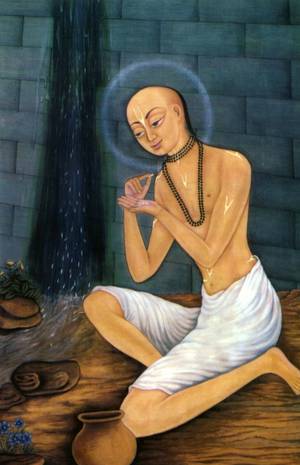 http://gaudiyahistory.iskcondesiretree.com/wp-content/uploads/2011/08/Raghunatha-Dasa-Goswami-193x300.jpg 193w" sizes="(max-width: 300px) 100vw, 300px" />
http://gaudiyahistory.iskcondesiretree.com/wp-content/uploads/2011/08/Raghunatha-Dasa-Goswami-193x300.jpg 193w" sizes="(max-width: 300px) 100vw, 300px" />
Shrila Raghunatha Dasa Goswami.
Born in a dynasty of Vaishnavas, Raghunatha Dasa Goswami was the only son of a wealthy land owner. As a boy, he received Haridasa Thakura's association and blessings. At fifteen he met Lord Chaitanya. By the mercy of Lord Nityananda he renounced a beautiful wife and an opulent family. He ran to Jagannatha Puri to intimately serve Shri Gaura Raya and his siksha guru Svarupa Damodara Goswami for sixteen years. Lord Gauranga gave His personal Govardhana Shila and gunja mala to Raghunatha Dasa Goswami.
Raghunatha Dasa couldn't live after Shri Chaitanya Mahaprabhu left this world. So, he came to Vrindavana to end his life by jumping off Govardhana Hill. Shri Rupa and Sanatana Goswamis affectionately received him. They convinced him to live on and enlighten all the Vrajavasi Vaishnavas with Shriman Mahap
hr ·

How did we come to be in the material world if our original position was living with God in the spiritual world? Why would we come down here to a place where there is birth, suffering, old age disease and death? The answer is that God gives us independence and free will always. He does not force us to do anything. When a child says to the father that he wants to do such and such, the father says no, you shouldn’t do it. It is not a good idea. But the child insists and wants to do it anyway. So the father relents and says okay, you can do it but you do so at your own risk. He gives permission because he loves his child. It is similar with God and we, His children, when we want to come down here to the material world and enjoy separately from Him. We like to think we know better.
If one can search out the original pure identity of the soul or self, then all the temporary isms will evaporate. Meanwhile down here on the earth plane, all who live have a right to exist, as Krsna says "Never was there a time when I did not exist, nor you, nor at any time in the future shall any of us cease to be". Supremacy may or may not be there in any given sphere, but among humans, in allegory, the best son does not have a right to kill and eat all the other sons. In nature, all but the unfit survive, so there is no question of struggle for existence and the topmost only survive, that's a lie. But some want to lord it over others...
So this "being" that Krsna mentions, ie we, manifest pastimes either in the pure ego realms called the spiritual sky para-vyoma, or else in the temporary seperatist realms that we call the material worlds, such as Earthly existences. Different laws apply to each realm. Bearing these things in mind, spiritual culture enthrones itself in a material for
Vedic Influence in Iraq and Iran
2Long, before the advent of Islam, even as early as the third millennium BCE, India had cultural bonds with the Mesopotamian civilization, now the region of Iraq and Iran. As explained by N. N. Bhattacharya, there are plenty of references to establish a very close contact between India and the Islamic world. Actually, Iraq was an area that had been a part of the Vedic civilization at one time. The extreme antiquity of India’s trade with the West-Asia (now known as middle-east) is an established fact.
In the Rig Vedic age, Afghanistan and its neighboring countries were culturally a part of ancient India, Bharatvarsha, and ancient Iran was also hardly distinguishable from India. It is recognized that some forms of Vedic culture prevailed in Western Asia. According to the Syrian writer Zenob, there was an Indian colony in the canton of Taron (in the region of modern day Turkey) on the upper Euphrates, to
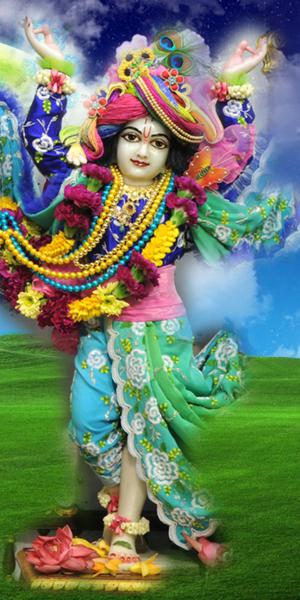
He mentions an especially touching conversation Shri Gaurasundara had with Vishnupriya Devi the night before He took sannyasa. Being a talented musician, Lochana Dasa told Mahaprabhu's pastimes in beautiful poetry filled with fire and rhythm. Common people could easily understand the divine character of Shri Chaitanya and awaken their religious feelings. As Devotees regularly chant the Vedic epics Ramayana and Mahabharata, Gaudiya Vaishnava's still wander through Bengal reciting the Chaitanya Mangala. (In the image: Shri Gaurachandra, ISKCON Chowpatty, Mumbai).
Shri Lochana Dasa Thakura was a disciple of Shri Narahari Sarakara Thakura, a dearest associate of Lord Gaura Raya.
"My hope of hopes is to be near the lotus feet of Shri Narottama Dasa Thakura and serve him with my very life. The cherished desire of the fallen Lochana Dasa is to be allowed, by Narahari's grace, to sing the glories of Lord Gauranga. My Lord is Shri Narahari Thakura, I am His servant. Bowing before him I b
Japan : The Phoenix Of Bharata
Just like the Sun worshipers of Japan. Previously it was part of a huge land mass in the
Śrīla Prabhupāda Says -
"The God says that "Here is injustice, so you should fight." God says that. God never says that "I am God, Kṛṣṇa. I am your friend. You sit down idly and I shall do everything." He never said that. He said that "You must fight." That is our duty, not that God has given us hands and legs and you sit down idly and let God do it. This is not devotion."
[SB: Lecture 1.2.6 - Mauritius 5 Oct 1975]

"Unfortunately, when the acarya disappears, rogues and nondevotees take advantage and immediately begin to introduce unauthorized principles ............The acarya, the authorized representative of the Supreme Lord, establishes these principles, but when he disappears, things once again become disordered."
(Srimad-Bhagavatam 4.28.48, purport)
Quote -From SB-By His Divine Grace AC Bhaktivedanta Swami-Srila Prabhupada ----

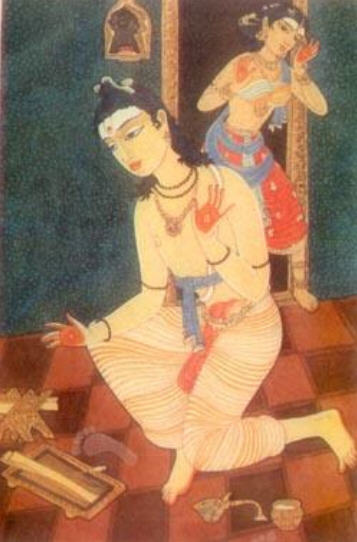
Three hundred years before the appearance of Shri Chaitanya Mahaprabhu, Shri Jayadeva Goswami served as the court pandita of Shri Lakshmana Sena, King of Bengal. Jayadeva and Padmavati (his wife and an expert dancer) used to worship Lord Shri Krishna with single-minded devotion. (In the image: Jayadeva Goswami and his wife Padmavati).
Three hundred years before the appearance of Shri Chaitanya Mahaprabhu, Shri Jayadeva Goswami served as the court pandita of Shri Lakshmana Sena, King of Bengal. Jayadeva and Padmavati (his wife and an expert dancer) used to worship Lord Shri Krishna with single-minded devotion. After some time, he left the opulent royal life to live peacefully in a grass hut in Champahatti, Navadwipa. Here Jayadeva wrote Gita Govinda.
One day while working on Gita Govinda Jayadeva felt inspired to write, "Krishna bows down to touch the lotus feet of Shrimati Radharani." Jayadeva was hesitant to say something which might diminish Lord Krishna's position as the Supreme
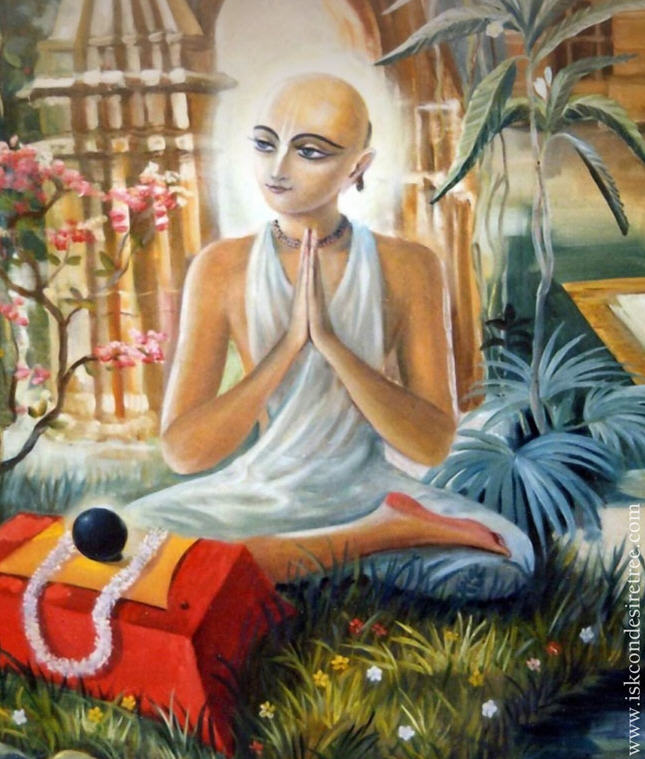
Shri Gopala Bhatta Goswami.
Shri Gopala Bhatta Goswami (the son of a Vyenkata Bhatta, a Shri Vaishnava brahmana) appeared in Shri Rangam, South India. Lord Chaitanya once stayed four months in his home, and converted the family to Gaudiya Vaishnavism. A mere boy at this time, Gopala personally served the Lord. Shri Chaitanya treated him affectionately giving His remnants and blessings to' become an acharya.
During His four month stay, Lord Chaitanya developed a close friendship with Vyenkata Bhatta, which Krishna Dasa Kaviraja describes as "sakhya rasa." Freely conversing with each other, they would often laugh and joke together. One day in a humorous mood Lord Chaitanya asked Vyenkata:
"Why does your worshipable goddess of fortune, Shri Lakshmidevi, abandon the happiness of Vaikuntha and her service to Her Lord Narayana? Why does she go to Vrindavana and perform severe austerities to attain the association of My Lord Gopala, the cowherd boy of Vraja?"
"I can't understand thes
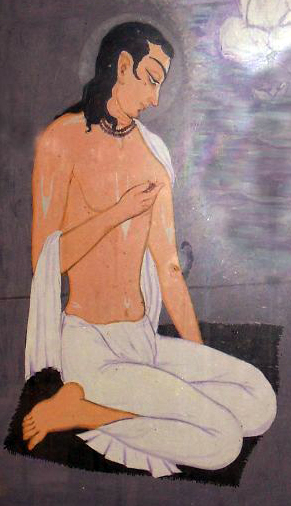
"Whether blind or dumb, anyone can drown in this flood of prema. In this way, Shri Chaitanya Mahaprabhu has filled everyone with love of God. But Ramachandra Dasa is so unfortunate that he couldn't even taste a drop of that nectar." (In the image: Shrila Ramachandra Kaviraja).
Ramachandra Kaviraja, the son of Shri Chiranjiva Sena (eternal associate of Lord Chaitanya), appeared in Shri Khanda. "Ramachandara Kaviraja was especially earnest, beautiful, intelligent, energetic, and enthusiastic," said one biographer. Although married, Ramachandra and his wife, Ratanala, had no material attachments. They stayed fully engaged in the loving service of Shri Chaitanya Mahaprabhu. They had no children. With steadfast devotion he served his spiritual master, Shrinivasa Acharya. In Vrindavana, Shri Jiva Goswami gave him the title, kaviraja, "king of poets." He wrote the following beautiful verse:
prakasila mahaprabhu hare krishna mantra
andha avadhi yata kare pa
According to this book Festivals, Fairs and Fasts of India regarding the Ganga Sagara Mela it says, "In Bengal, the Ganga Sagara festival (Mela) is held on Makara Sankranti (15th January when the sun goes from kumbha [Aquarius] rasi to makara [Pisces] rasi) on Sagara Island. Sagara means the ocean, and the island is located where the river Ganga enters the ocean. A well-attended fair is held and people come from long distances to bathe here. After the bath Ganga Ma or the Goddess Ganga is worshipped. It is believed that Ganga entered the ocean at this point to wash the bones of the 60,000 sons of Sagara, in whose memory the island is held sacred. There were reportedly killed by a curse from sage Kapila
(see Ganga Dussehra)"page 17.
Ganga Dussehra:
"Festivals connected with rivers are essentially bathing festivals. Ganga Dussehra is celebrated on the tenth day of Jyeshtha. River Ganga is worshipped as a mother as well as a Goddess, particularly by people of Uttara Pradesh, Bihar, and Benga
The Sun enters the Makara raasi (the zodiac sign of Capricorn - the goat), on Sankranti day, signifying the onset of Uttarayana Punyakalam.
The following has been translated from an article in Sadachara Vybhavam of the great Vaishnava devotee Sripad Madhwacharya.
Today is "Makara Sankranti" which is celebrated when the Sun begins the northward journey, marking the beginning of the "uttaraayaNa puNyakaalam". Sun enters the sign of "Makara", (Capricorn) from Cancer at this time. (This is also called equinox, when the day and nights are exactly the same). Starting this day, the duration of day starts to increase until "dakshiNaayanam" comes. Makara Sankranti signifies two things. One is the changing path of Sun and other is the beginning of "Uttarayana Punyakaala" Makara literally means
"Capricorn" and sankranti means "change" or 'sankramaNa' literally means 'crossing'. On this day, it is said that Sun passes from one Zodiac sign to another. A sankranti or sankramaNa marks the beginning of

What is the difference between a pure devotee and a mixed devotee ?
Srila Prabhupada..."The sunrays are open to everyone, but the capacities of the receptacles differ. Foolish people think that devotional service is flattering the Lord to get special mercy. Factually the pure devotees who are engaged in the transcendental loving service of the Lord are not a mercantile community. A mercantile house renders service to someone in exchange for values. The pure devotee does not render service unto the Lord for such exchange, and therefore the full mercy of the Lord is open for him. Suffering and needy men, inquisitive persons, or philosophers make temporary connections with the Lord to serve a particular purpose. When the purpose is served, there is no more relation with the Lord. A suffering man, if he is pious at all, prays to the Lord for his recovery. But as soon as the recovery is over, in most cases the suffering man no longer cares to keep any connection with the L
To serve Krsna means practically, and means using everything. -T dasa

Biren Chauhan to ONLY PRABHUPADA
"The real question is, How can we remain unpolluted by material contamination while in the material world? It was Rūpa Gosvāmī who explained that we can remain uncontaminated while in the world if we simply make it our ambition to serve Kṛṣṇa. One may then justifiably ask, "How can I serve?" Obviously this is not simply a matter of meditation, which is just an activity of the mind, but of practical work. Love of Kṛṣṇa's service can be attained only by working for Kṛṣṇa. In such work, we should leave no resource unused. Whatever is there, whatever we have, should be used for Kṛṣṇa. We can use everything: typewriters, automobiles, airplanes, missiles-anything. If we simply speak to people about Kṛṣṇa consciousness, we are also rendering service. If our minds, senses, speech, money and energies are thus engaged in the service of Kṛṣṇa, we cannot be con
